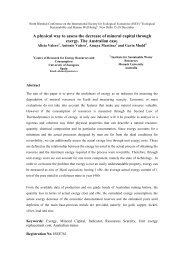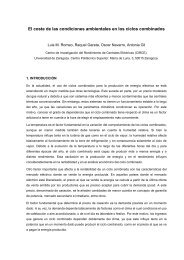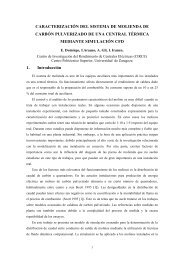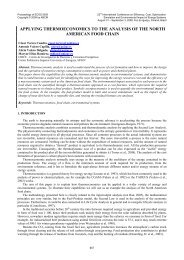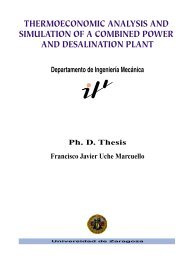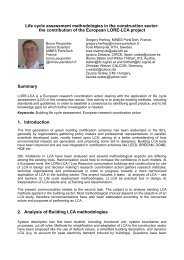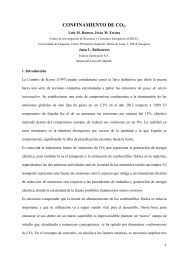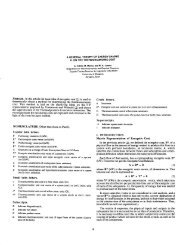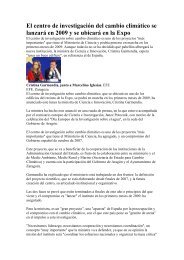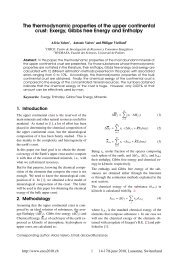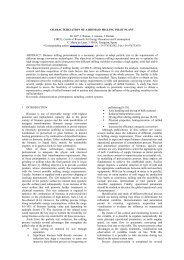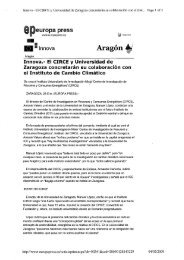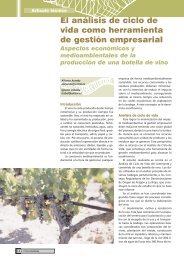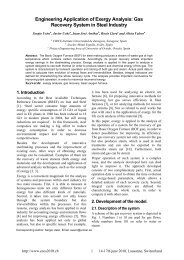towards an international legal reference environment
towards an international legal reference environment
towards an international legal reference environment
You also want an ePaper? Increase the reach of your titles
YUMPU automatically turns print PDFs into web optimized ePapers that Google loves.
St<strong>an</strong>dard chemical exergy of chemical compounds<br />
Methodology<br />
St<strong>an</strong>dard chemical exergy results from a conventional<br />
assumption of a st<strong>an</strong>dard ambient temperature<br />
<strong>an</strong>d pressure <strong>an</strong>d st<strong>an</strong>dard concentration of <strong>reference</strong><br />
subst<strong>an</strong>ces in the natural <strong>environment</strong>.<br />
The st<strong>an</strong>dard chemical exergy of <strong>an</strong>y chemical<br />
compound c<strong>an</strong> be calculated by me<strong>an</strong>s of the exergy<br />
bal<strong>an</strong>ce of a reversible formation reaction;<br />
bchn = ∆G f +∑ e<br />
ne bchne<br />
(1)<br />
where:<br />
∆G f formation Gibbs energy<br />
ne amount of kmol of the element e<br />
bchne st<strong>an</strong>dard chemical exergy of the element.<br />
If the chemical element does not belong to the <strong>reference</strong><br />
subst<strong>an</strong>ces, its st<strong>an</strong>dard chemical exergy c<strong>an</strong><br />
also be calculated from Eq. 1, however, a <strong>reference</strong><br />
reaction of this element should be formulated. This<br />
reaction contains only <strong>reference</strong> subst<strong>an</strong>ces, additional<br />
as react<strong>an</strong>ts <strong>an</strong>d final as products. For example,<br />
following <strong>reference</strong> reaction holds for the element<br />
C: C+O2 = CO2, where O2 is the additional<br />
<strong>an</strong>d CO2 the final <strong>reference</strong> subst<strong>an</strong>ce. The st<strong>an</strong>dard<br />
chemical exergy of the <strong>reference</strong> subst<strong>an</strong>ces are calculated<br />
prior to the st<strong>an</strong>dard chemical exergy of the<br />
element.<br />
Discussion of the variables used<br />
The formation Gibbs energy used by Szargut [12]<br />
was revised by Rivero [14] using [15], [16], [17],<br />
[18] <strong>an</strong>d [19]. No subst<strong>an</strong>tial differences were<br />
found, except for sillim<strong>an</strong>ite (Al2SiO5), whose new<br />
value is ∆G f = 2440,9 kJ/mol. The information<br />
source of R<strong>an</strong>z [13] for obtaining ∆G f , was Faure<br />
[20], which is a compilation of the literature from<br />
several authors. This source corroborates Rivero’s<br />
revision <strong>an</strong>d thus, it will be considered for the calculation<br />
of our particular R.E.<br />
Gaseous <strong>reference</strong> subst<strong>an</strong>ces<br />
Methodology<br />
Free chemical elements present in the atmospheric<br />
air (O2, N2, Ar, He, Ne, Kr, Xe) <strong>an</strong>d the compounds<br />
H2O, CO2 are assumed as <strong>reference</strong> sub-<br />
st<strong>an</strong>ces. Their st<strong>an</strong>dard chemical exergy results from<br />
the conventional st<strong>an</strong>dard concentration in the atmosphere;<br />
bchn = −RT0 ln P0n<br />
= −RT0 ln z0<br />
Pn<br />
(2)<br />
where:<br />
R gas const<strong>an</strong>t,<br />
T0 st<strong>an</strong>dard ambient temperature (298,15 K),<br />
P0n conventional me<strong>an</strong> ideal gas partial pressure<br />
in the atmosphere (kPa),<br />
Pn st<strong>an</strong>dard pressure (101,325 kPa),<br />
z0 conventional st<strong>an</strong>dard molar fraction in the<br />
<strong>environment</strong>.<br />
The values of st<strong>an</strong>dard chemical exergy of gaseous<br />
<strong>reference</strong> subst<strong>an</strong>ces O2, H2O, CO2, N2 are calculated<br />
before other values because they are necessary<br />
in the calculation of st<strong>an</strong>dard chemical exergy of<br />
non-gaseous <strong>reference</strong> subst<strong>an</strong>ces.<br />
Discussion of the variables used<br />
The universal gas const<strong>an</strong>t is used (8,3143 kJ/(kmol<br />
K)) <strong>an</strong>d the calculated st<strong>an</strong>dard chemical exergy relates<br />
to 1 kmol. Rivero <strong>an</strong>d Garfias [14] accepted<br />
the <strong>reference</strong> pressure according to the conventional<br />
unit “physical atmosphere”, thus 101,325 kPa. We<br />
are assuming the me<strong>an</strong> partial pressure calculated by<br />
Szargut <strong>an</strong>d used by R<strong>an</strong>z [13], which is the really<br />
appearing me<strong>an</strong> value <strong>an</strong>d is equal to 99,31 kPa.<br />
Table 2 shows the results obtained in this study for<br />
the chemical exergy of the gaseous subst<strong>an</strong>ces. The<br />
obtained values are the same of those obtained by<br />
Szargut [12] <strong>an</strong>d Valero, R<strong>an</strong>z <strong>an</strong>d Botero [2], since<br />
the methodology <strong>an</strong>d the values used for this R.E.<br />
has been the same. The differences with Rivero <strong>an</strong>d<br />
Garfias [14] are due to the different partial pressures<br />
in the atmosphere taken.<br />
Solid <strong>reference</strong> subst<strong>an</strong>ces<br />
Methodology<br />
For a prevailing part of chemical elements, solid<br />
R.S. commonly appearing in the external layer of<br />
the continental part of Earth’s crust, have been assumed.<br />
However, the Earth’s crust is a very complicated<br />
mixture of solid solutions <strong>an</strong>d <strong>an</strong> exact calculation<br />
of the chemical exergy of its components<br />
is impossible. We c<strong>an</strong> only approximately evaluate



